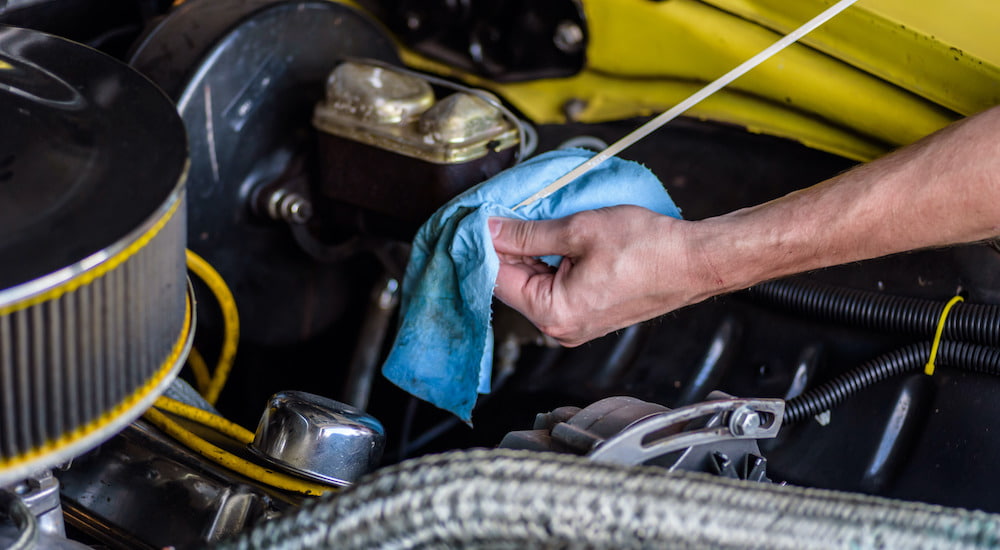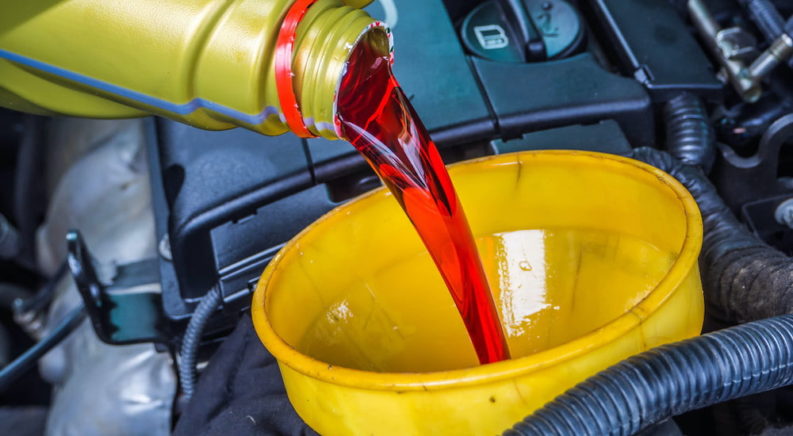What’s your favorite Nissan model? Whether you have a workhorse like the Titan sitting in your driveway, a family-friendly SUV like the Pathfinder, or an efficient and comfortable sedan like the Altima, one of the best ways to ensure your Nissan’s longevity is to stay current with its routine maintenance. While most drivers are pretty good about getting the oil changed and tires rotated, one large part of Nissan maintenance you can do yourself is to check the transmission fluid.
Why is checking your Nissan’s fluid levels vital for your vehicle’s longevity? More importantly, how do you do it, and does it require a mechanic? And are there any other fluids that you are forgetting to check? We’ve got those answers and more in this step-by-step guide that will ensure your Nissan is always ready for the road!
Transmission Fluid: What It Is and How to Check It
You likely drive past several quick-lube garages on your daily commute or when you’re running errands around town. These garages are an instant reminder of the importance of oil changes and routine maintenance for your Nissan. After all, oil lubricates the engine to keep it running smoothly and at its optimal temperature. But what about the transmission and its fluid? Isn’t that just as important as engine oil?
The transmission is a key component in your Nissan’s powertrain, translating the engine’s power into something usable by the wheels. The transmission in any vehicle works overtime when you’re hauling heavy loads, towing trailers, or navigating city streets with stop-and-go traffic. If the fluid in your transmission begins breaking down, it can lead to expensive repairs. Why? The transmission fluid works as both a lubricant and hydraulic fluid. It lubricates the components that cause the gears to shift, and it cools the transmission to maintain its ideal operating temperature.

How to Check Your Transmission Fluid
Step #1: Gather Your Supplies and Prep Your Nissan
Typically red in color, transmission fluid is easy to check and generally requires very few supplies – just a clean rag and a small screwdriver or pick. However, it can depend on the type of transmission you have. Most recent Nissan models use a Continuously Variable Transmission (CVT), so that’s what we are focusing on here. However, if your Nissan has a traditional automatic, a manual, or (for those lucky GT-R drivers) a dual-clutch automatic, checking your transmission fluid is still possible.
Once you have your supplies, make sure to warm up your transmission. Since transmission fluid expands when it gets hot, warming up the transmission will give you a more accurate reading. The best way to do this is by taking a short drive with plenty of starts and stops – simply turning on the engine and leaving the vehicle in park will only warm up the engine, not the transmission. After you have done this, you will want to refer to your owner’s manual since many Nissan models suggest keeping the engine running while you check the fluid.
Step #2: Checking the Health of Your Transmission Fluid
In order to find the transmission dipstick, it is best to refer to your owner’s manual. Once the dipstick has been located, remove the transmission dipstick (this may require unlatching it using a screwdriver or pick) and wipe it using a clean rag just like you were checking your oil. Then, look at the rag to examine the color, smell, and consistency of the fluid. Healthy transmission fluid should generally be red or light brown, free of debris and bubbles, and odorless. If the fluid is dark, filled with debris, or smells burnt, then your fluid needs to be replaced.
Step #3: Checking the Level of Your Transmission Fluid
Now that you’ve checked the fluid itself, it’s time to check the level of your transmission fluid. If your transmission fluid is healthy, you’ll reinsert the dipstick and pull it out again. This time, look at the two lines on the dipstick. Ideally, the transmission fluid should be somewhere between these two lines, just like on an oil dipstick. If it is below the lower line, you’ll need to add more transmission fluid using the funnel. Once you add more fluid, check the levels again.
When adding fluid, make sure you are using the correct type. CVTs, traditional automatics, and manuals all use transmission fluid differently and require different types of fluid. Using the wrong type of fluid can cause significant harm to your transmission. When in doubt, always take your vehicle to a professional.
Step #4: Getting Into a Routine
Once you’ve checked your transmission fluid, it’s a good idea to set a maintenance routine. Most mechanics recommend changing your transmission fluid every 50,000 to 100,000 miles, but this often depends on your driving habits. For example, regularly towing heavy loads or frequent stop-and-go driving is harder on the transmission and will usually require more frequent fluid checks. Evaluate your most frequent type of driving and get into a habit of regularly checking your fluid level to ensure your Nissan is always operating at its best.

Other Fluids and How to Check Them
In addition to transmission fluid, there are three other fluids that you’ll want to check on your Nissan. You probably already know about engine oil and windshield wiper fluid, but you should also keep an eye on the engine coolant, brake fluid, and (on older models) power steering fluid. Each of these fluids serves a specific purpose to ensure your Nissan runs smoothly and is an important part of your Nissan’s routine maintenance that you can monitor yourself.
Brake fluid is a hydraulic fluid that pushes the brake calipers closed when you press the brake pedal to stop your Nissan. Old or overheated brake fluid will apply less pressure, leading to reduced stopping performance. Engine coolant circulates heat through the radiator, keeping the engine cool. Coolant will last 100,000 miles or more on modern cars, but it is always good to check it occasionally. Finally, power steering fluid allows you to turn the wheel more easily, although recent Nissan models use electric power steering that doesn’t have power steering fluid (the Nissan Frontier being an exception that actually just returned to hydraulic power steering for the 2022 model year).
Checking Motor Oil
If you haven’t checked your engine oil before, it is a simple process. You’ll need to park your Nissan on level ground, check your owner’s manual for the type of oil required, and grab a clean rag. The engine needs to be turned off when you check the oil level, but it is good to warm it up first. When you locate the oil dipstick, pull the dipstick out of the engine and wipe it on the rag.
After you’ve examined the oil’s color and consistency, reinsert the dipstick and remove it again to check the oil level. Similar to checking your transmission fluid, the oil line should fall between the two markings. If it falls below the lower line, then you can use a funnel to add more oil – just make sure to use quality oil of the appropriate type for your car. Once you’ve added more oil, recheck the dipstick to ensure it’s at the appropriate level.
Checking Brake Fluid
When you press the brake pedal, brake fluid pressurizes to close the calipers and bring your Nissan to a complete stop. This makes checking your brake fluid an important step in maintaining your Nissan because low or old brake fluid can be extremely hazardous and cause your vehicle’s brakes to fail.
To check your brake fluid, use your owner’s manual to identify where the brake fluid reservoir is under the hood of your Nissan. The exterior of the reservoir will show two lines – a minimum and maximum. Identify where your brake fluid is between the lines and check the color of the fluid; it should be mostly clear with a slight tint rather than dark brown or black with an oil-like consistency. If the brake fluid looks more like oil, then it needs to be replaced. However, if the fluid is healthy, but the level is low, you know that it’s time to have your brakes serviced.
Create a Maintenance Schedule
What does your Nissan’s maintenance routine look like, and how often do you check your fluid levels? By checking and sticking to a regular maintenance schedule, you’re proactively ensuring your Nissan’s longevity. From keeping the engine and transmission lubricated to giving your brakes the stopping power they need, routine fluid checks are a vital part of what keeps your Nissan performing at its best.

